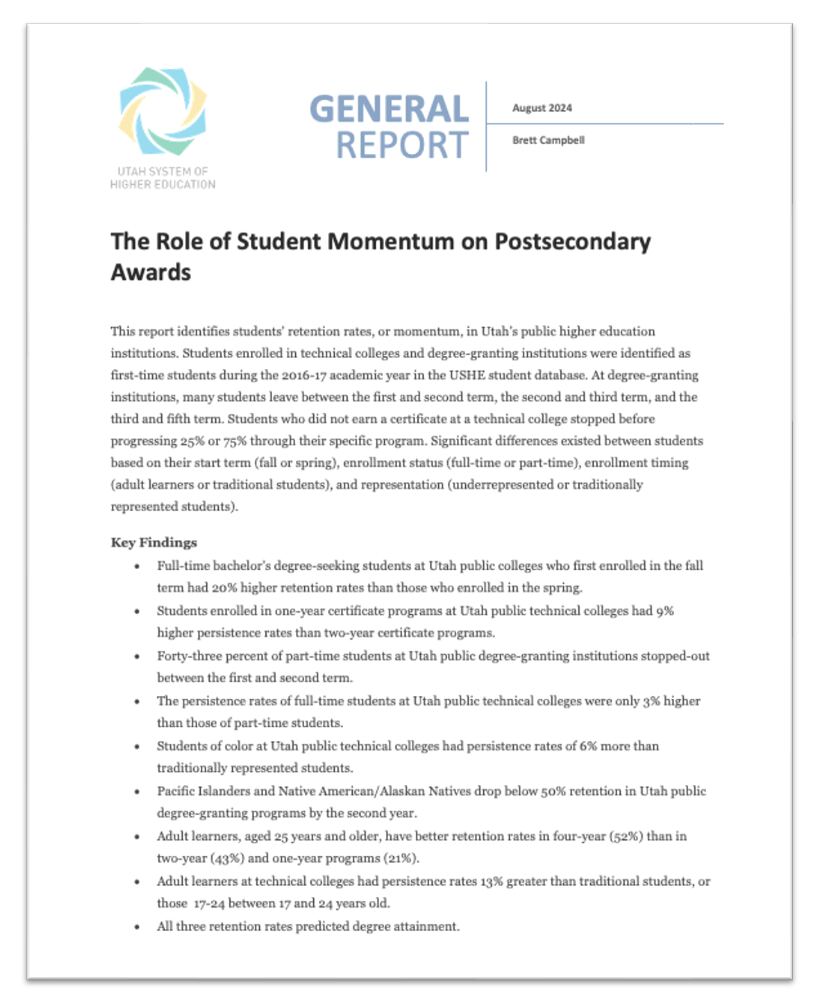Not completing college has serious consequences. College students who drop out earn lower salaries (Beagley and Brandley 2024; Rooney et al. 2006). They also report higher poverty levels, unemployment, and incarceration rates (Tinto 2012). College dropouts are less engaged in their community and volunteer less (Barbera et al. 2020). However, students can finish their programs with sufficient momentum and improve their quality of life.
Tracking student momentum, or persisting from term to term towards attaining a degree, is crucial. Reviewing retention rates assists institutions and the Utah System of Higher Education to identify individual and systemic barriers. Using USHE data, students who first enrolled in the 2016-17 academic year were tracked until they dropped out or earned a degree. Students at both technical colleges and degree-granting institutions were included. Retention rates were calculated over the first three years and if a student earned at least one certificate or degree. Students who first enrolled in either the fall or spring term were included as those who enrolled full-time or part-time. Momentum differs whether a student enrolls in a degree-granting institution or a technical college.
Finding 1: Students attending Utah’s degree-granting institutions persist better when they enroll full-time and begin in the fall.
Full-time bachelor’s degree-seeking students at Utah public colleges who first enrolled in the fall term had 20% higher retention rates than those who enrolled in the spring.
Full-time associate degree-seeking students who first enrolled in the fall had approximately 22% higher retention rates than those who enrolled in the spring.
- Forty-three percent of part-time students at Utah public degree-granting institutions stopped-out between the first and second term.
- Students enrolled in one-year programs at degree-granting institutions had higher retention rates when they started in the fall and as full-time students.
- Failing a course at a degree-granting institution was the most significant barrier persisting to a degree or certificate.
Finding 2: Students enrolled in one-year programs at technical colleges had higher momentum than those who enrolled in two-year programs.
- Of the part-time students who did not finish their one-year program, 64% persisted past one-half of the program before stopping out.
- Of full-time students who enrolled in one-year programs and did not finish, 71% persisted through at least one-half of their program.
- Most students enrolled in two-year programs persisted through one-half of the program (part-time 65% and full-time 61%).
Finding 3: Women, underrepresented students, and adult learners had higher retention rates than traditional students.
Most students of color who did not finish, completed 75% of their certificate program.
Adult learners had better retention rates in bachelor’s degree programs and at technical colleges.
- Women seeking bachelor’s degrees had higher retention rates between the first and second term, but afterward, men had higher retention rates.
- Women seeking associate degrees had significantly higher retention rates than men.
- At degree-granting institutions, Asian American students and those who identified as two or more racial or ethnic identities had the highest momentum.
- Native American/Alaskan Native and Pacific Islander students had the lowest retention rates.
- Black/African American students showed significant drops in retention when enrolled in associate degree programs.
Limitations
- Technical college data included only initial enrollment through the first award date by program cluster. This means students who transferred to a different program cluster could be included as students who stopped out, which may artificially raise the number of students who did not complete technical college.
- Most of these analyses were descriptive and did not identify causal relationships. Graphs and descriptions may imply causal relationships; however, statistical analyses demonstrating causality were not conducted.
- Specific demographic data were unavailable, including low economic status or first-generation students. Analyses that should have included these demographics were not possible. These students face additional challenges beyond the ability to pay tuition and fees, including the need for greater academic capital or the knowledge and ability to maneuver the higher education environment (Collier and McMullen 2023; Kamer and Ishitani 2024; Pratt et al. 2019). This, in turn, would affect these students’ sense of belonging (Pedler et al. 2022).
- This data focuses on students who attended public higher education institutions and should be considered a subset of the total state student population. Students who attended private higher education institutions were not included, nor were those who attended online institutions. Approximately 39% of Utah’s college students attend private institutions (Chingos 2017). Additionally, the United States Department of Education reported that approximately 20% of students in four-year and 41% of students in two-year degree programs attend online (NCES 2022).
Conclusion
Determining the best retention rate depends on how students are classified. If only one rate were chosen, the second-year retention rate might be the best option when tracking four-year degree seekers, but two-year programs differ by the award sought, so different retention rates are used. When a student pursues an associate degree, the second-term retention rate is better, but the second-year retention rate is preferable for two-year certificate programs. Tracking students with both second-term and second-year metrics would provide more support for students enrolled in bachelor’s and two-year certificate programs. Circumstances may differ according to the characteristics of individual institutions.
USHE technical colleges successfully moved students toward completion, with almost three out of four students earning certificates. Most students were close to finishing their one-year program if they did not finish within the time frame of this study. If technical colleges were to track student momentum, the 50% progress completion could be the best choice. One difference between technical colleges and degree-granting institutions is that part-time status is not a barrier for technical college students.
This report is a comprehensive study that identifies students’ retention rates, or momentum, in public higher education institutions in Utah. It includes first-time students from technical colleges and degree-granting institutions identified in the USHE student database during the 2016-17 academic year.

Glossary
- Dropout: A student who left without an award, does not return within seven terms, and does not transfer to another public Utah institution.
- Momentum: A student’s ability to persist from term to term toward earning an award. Momentum is measured via retention rate.
- Persistence Mark: The percentage of a program a student completes at a technical college.
- Retention Rate: The proportion of students who persist from one term to another. The most common rates are between the first and second term or between the first and third term.
- Stop out: A student who left without an award returned within seven terms and did not transfer to another institution.

